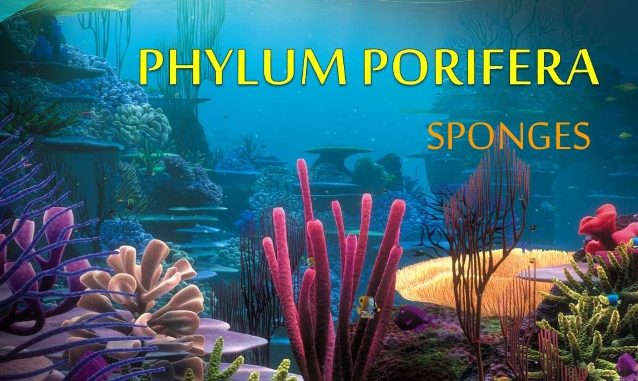
General characteristics of Phylum Porifera
- Kingdom: Animalia
- Habitat: Aquatic, mostly marine, few are terrestrial
- Habit: They are solitary or colonial.
- Grade of organization: cellular grade of body
- Shape: Body shape is variable, mostly cylinder shaped
- Symmetry: Asymmetrical or radially symmetrical.
- Germ layer: Diploblastic animals. The adult body wall contains two layers, outer dermal layer and inner gastral layer. In between these two layers, there is a gelatinous and non-cellular mesoglea containing numerous free amoeboid cells.
- Coelom: Absent; acoelomate but spongocoel is present
- Surface of the body has numerous perforation called ostia (for the entry of water) and a large pore at the apex called osculum (for the exit of water).
- Water canal system present
- Endoskeleton: Either calcareous spicules (calcium carbonate) or siliceous spicules (silica) or sponging fibers (protein).
- Nutrition: holozoic
- Digestion: Intracellular
- Nervous system: absent
- Circulatory system: absent
- Reproduction: Asexual: by budding or gemmule or regeneration; Sexual: gamatic fusion
- Fertilization: Internal
Classification of Phylum Porifera
Based on the type of skeleton system the phylum Porifera is divided into three classes
- Class 1: Calcarea or Calcispongiae
- Class 2: Hexactinellida or Hyalospongiae.
- Class 3: Demospongiae
Class 1: Calcarea or Calcispongiae
(calcarius: lime / calcium))
- Habitat: Exclusively marine
- Habit: Solitary or colonial nature.
- Endoskeleton: calcareous spicules composed of calcium carbonate
- Symmetry: Radially symmetry
- Shape: Cylindrical shape
- Examples: Sycon, Leucosolenia
Class 2: Hexactinellida or hyalospongiae:
(Hex: six, actin: ray, idea: terminal)
- Habitat: Exclusively marine (deep sea)
- Habit: Solitary in nature.
- Endoskeleton: six- rayed siliceous spicules.
- Symmetry: Radially symmetry
- Shape: Cylindrical shape.
- Examples: Euplectella, Hyalonemma
Class 3: Demospongiae
(Demos: frame)
- Habitat: Mostly marine and some are freshwater
- Endoskeleton: Siliceous spicules or sponging fibres or both or none
- The spicules are monaxon or tetraxon but never six-rayed
- Symmetry: asymmetrical.
- Shape: Irregular
- Canal system complicated.
- Spongocoeal is totally absent.
- Examples: Spongilla.
